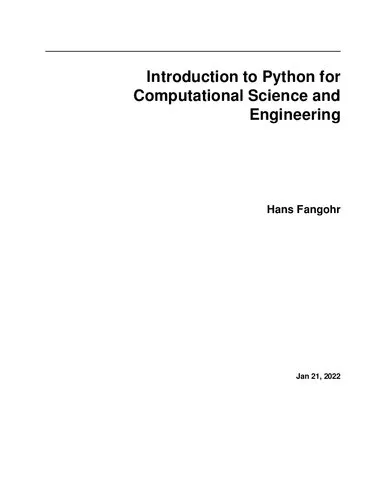An Introduction to Python for Computational Science and Engineering
4.3
Reviews from our users

You Can Ask your questions from this book's AI after Login
Each download or ask from book AI costs 2 points. To earn more free points, please visit the Points Guide Page and complete some valuable actions.Introduction to "An Introduction to Python for Computational Science and Engineering"
"An Introduction to Python for Computational Science and Engineering" is a comprehensive textbook designed to bridge the world of programming and scientific computation. Written by Hans Fangohr, this book provides an accessible and practical guide for students, researchers, and professionals who aim to utilize Python as a tool for solving complex scientific and engineering problems. The book focuses on equipping readers with the essential programming skills they need alongside a deep understanding of computational methods, enabling them to apply these concepts effectively in their respective disciplines.
Detailed Summary of the Book
Programming has become an indispensable skill in modern-day science and engineering, and Python has emerged as one of the most popular programming languages in these domains. This book begins by introducing Python from scratch, making it accessible even to complete programming novices. Gradually, it builds upon that foundation to cover essential topics such as control flow, object-oriented programming, and numerical computation. The author places special emphasis on clarity and practical applications, using examples that are grounded in real-world scientific and engineering contexts.
The book isn’t purely about learning Python; instead, it connects programming to the art of computational thinking. Readers are introduced to fundamental numerical methods, including solving differential equations, numerical integration, matrix operations, and data visualization. Alongside, practical examples and exercises demonstrate how Python can be leveraged to implement these techniques efficiently.
With numerous exercises, carefully crafted examples, and practical code snippets, the book also highlights how Python libraries such as NumPy, SciPy, and Matplotlib can significantly amplify the computational power of scientists and engineers. As a hands-on guide, it encourages readers to actively try out code examples and adapt them to their own applications. The step-by-step approach ensures that absorption of programming concepts happens naturally alongside the mastering of computational methods.
Key Takeaways
- Learn Python basics and intermediate programming concepts tailored for computational scientists and engineers.
- Understand the principles of mathematical modeling and algorithm implementation using Python.
- Acquire hands-on experience with Python libraries such as NumPy, SciPy, and Matplotlib to visualize and solve numerical problems.
- Avoid common pitfalls in programming and achieve robust computational workflows.
- Develop practical problem-solving skills through exercises and detailed real-world examples relevant to science and engineering.
Famous Quotes from the Book
"Computational science is not about producing perfect results; it is about understanding the limitations of approximations and the judicious application of computational tools."
"Python empowers scientists and engineers to focus on their problems, rather than getting bogged down in implementation details."
Why This Book Matters
In a world increasingly dominated by data and computation, the ability to program effectively is no longer a luxury but a necessity. This book provides the foundation and skills required to harness the computational power of Python, enabling users to solve real-world problems across scientific and engineering domains. It demystifies programming, making it accessible and enjoyable for students and professionals who may have never coded before.
By emphasizing practical applications and presenting clear explanations, Hans Fangohr unlocks the potential for innovation and discovery through computation. This book cultivates confidence and competence in using Python not only as a programming language but as a problem-solving tool. Whether you’re analyzing large datasets, solving differential equations, or visualizing results, this text equips you with the tools to succeed in the computational world.
Free Direct Download
You Can Download this book after Login
Accessing books through legal platforms and public libraries not only supports the rights of authors and publishers but also contributes to the sustainability of reading culture. Before downloading, please take a moment to consider these options.
Find this book on other platforms:
WorldCat helps you find books in libraries worldwide.
See ratings, reviews, and discussions on Goodreads.
Find and buy rare or used books on AbeBooks.


